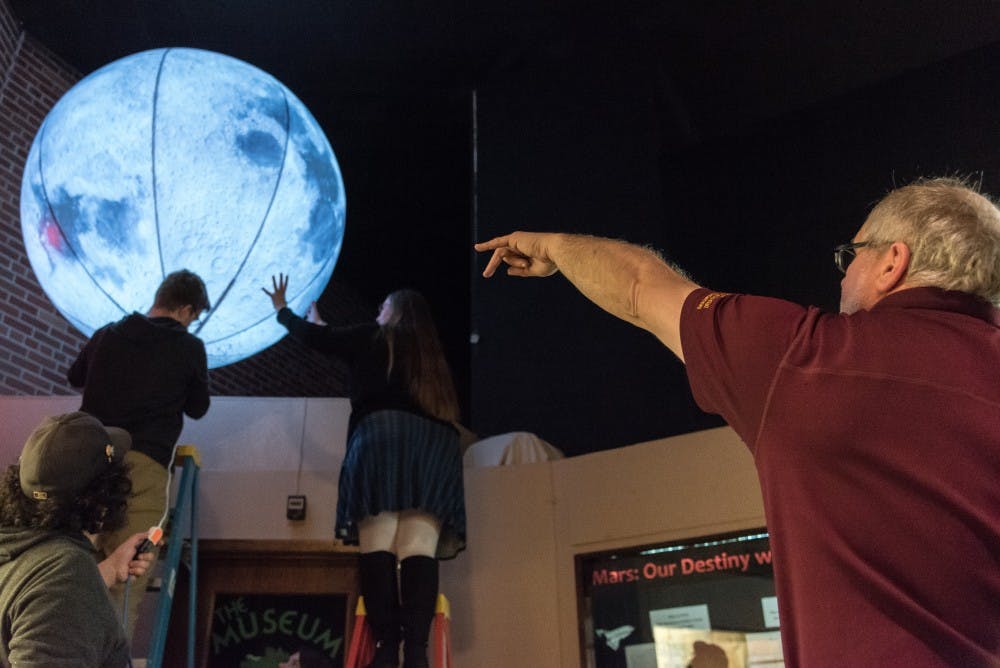Museum of Cultural and Natural History to present 'groovy' artistry, turmoil from 1960s

Volunteers fix a large blown-up moon to the ceiling of the Museum of Cultural and Natural History March 22 at Rowe Hall.
Mount Pleasant and Central Michigan University community members will be able to participate in traveling back to the 1960s at the Museum of Cultural and Natural History's "Kozmic Clash: Peace, love and outer space." The exhibit will open at 4 p.m. April 22.
Collections manager Ron Bloomfield said the museum is focused primarily on 1969 events like Woodstock and Apollo 11, but will allow visitors to experience pivotal developments in innovation, artistry and turmoil in the 60s and early 70s.
“They’re my little way of getting people ready and generating some ‘vibes,’” Avery said.
Bloomfield and a group of students are using Woodstock to present the counter culture, or hippie movement. Bloomfield described the event as the “crowning achievement” of the 60s.
“(Woodstock) was perhaps the biggest thing to happen in the 60s,” Bloomfield said. “The reason, according to sources, is that 500,000 people attended the concert, and they only had two deaths and a handful of arrests.”
As visitors enter Rowe from its southern or eastern entrances, they will relive the three-day event. Bloomfield said the museum is attempting to recreate the stage and crowd at Woodstock. A kiosk will allow visitors to learn about the performers and their significance to the event.
Along the walls, Bloomfield’s team will show psychedelic and mainstream album covers, photographs and quotations from the time. Bloomfield said his team has faced challenges being in a hallway and had to get creative with how they manage the space.
To solve certain challenges, the museum is also incorporating digital technologies instead of static displays. Jay Martin, director of the Museum of Cultural and Natural History, said the museum is experimenting with transparent cones which will project sound straight down. This allows the implementation of music.
Bloomfield plans to contrast the peace and love of the hippie movement with the turmoil of the Vietnam War.
To help visitors understand the artistry within the counter culture, the museum recently acquired a vintage Volkswagen van called “Honey Bear.” One side of the van is painted with chalkboard paint, which Martin said will allow visitors to creatively express themselves while providing a clean slate for the next group.
Research Collections Educator Caity Burnell’s hands-on exhibit, “Feel the Music,” is also focused on the artistry of the 60s. The exhibit is being created within a room off of the main hallway.
“The theme is that music is all around us, even on an individual level with rhythm and our heartbeat,” she said.
A violin, drum set and trumpet will give visitors an opportunity to play an instrument from three of the four major instrument families — strings, percussion and brass. An online music lab will implement a number of apps and games for visitors to play, teaching them about music through trial and error. A hands-on cart will also contain more instruments for individuals. Children with sensory issues can wear headphones provided by the museum.
“The 'Feel the Music' exhibit is supposed to be a fun, hands-on experience for children and families to make music and be inspired to go learn to play an instrument,” Burnell said.
Burnell said the museum’s goal is always to include students.
“The museum is a laboratory for a variety of students in museum studies and other related programs,” Martin said.
Grand Rapids graduate student Brad Davis has created an exhibit that explores the limited space of the museum. As part of his exhibit, Davis is using a blown-up Earth and moon hung from the ceiling of the museum to show the journey of Apollo 11. Davis said the Earth-to-moon ratio (three to one meter in diameter) is as close to their respective sizes as possible.
“Many people do not know the details of (Apollo 11),” Davis said, “A big part of the exhibit is showing how the astronauts may have been thinking, feeling and eating during their three-and-a-half day journey.”
The exhibit will also discuss how the Apollo 11 mission permeated culture in things like Star Wars and David Bowie’s “Space Oddity.”
The Museum of Cultural and Natural History is free and open 8 a.m.- 5 p.m. weekdays and 1 p.m.- 5 p.m. Saturday.






